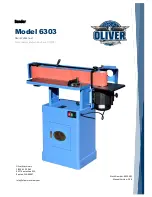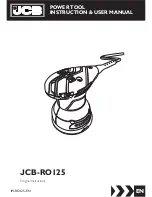
WARNING! Some dust particles created by power sanding, sawing,
grinding, drill and other construction jobs contain chemicals known
to cause cancer, birth defects or other reproductive harm.
Some
examples of these chemicals are:
• Lead from lead-based paints.
• Crystalline silica from bricks and cement and other masonry products.
• Arsenic and chromium from chemically treated timber.
Your risk from these exposures varies, depending upon how often you do
this type of work. To reduce your exposure to these dusts:
• Work in a well-ventilated.
• Work with approved protective equipment, such as those dust masks
that are specially designed to filter microscopic particles.
VIBRATION
The European Physical Agents (Vibration) Directive has been brought in to help reduce
hand arm vibration syndrome injuries to power tool users. The directive requires power
tool manufacturers and suppliers to provide indicative vibration test results to enable
users to make informed decisions as to the period of time a power tool can be used
safely on a daily basis and the choice of tool.
SEE TECHNICAL SPECIFICATIONS IN THE INSTRUCTION MANUAL FOR THE
VIBRATION LEVELS OF YOUR TOOL.
The declared vibration emission value should be used as a minimum level and should
be used with the current guidance on vibration.
Calculating the actual period of the actual period off use can be difficult and the HSE
website has further information.
The declared vibration total value has been measured in accordance with EN 62841-1
and EN 62841-2-4 and may be used for compare one tool with another.
The declared vibration total value may also be used in a preliminary assessment of
exposure.
Construction workers are one of the at-risk groups within this because of the dust that
they breathe: silica dust is not just a nuisance; it is a real risk to your lungs!
Silica is a natural mineral present in large amounts in things like sand, sandstone and
granite. It is also commonly found in many construction materials such as concrete and
mortar. The silica is broken into very fine dust (also known as Respirable Crystalline
Silica or RCS) during many common tasks such as cutting, drilling and grinding.
Breathing in very fine particles of crystalline silica can lead to the development of:
• lung cancer
• Silicosis
• Chronic obstructive pulmonary disease (COPD).
And breathing in fine particles of wood dust can lead to the development of Asthma.
The risk of lung disease is linked to people who regularly breathe construction dust
over a period of time, not on the odd occasion.
To protect the lung, the COSHH Regulations sets a limit on the amount of these dusts
that you can breathe (called a Workplace Exposure Limit or WEL) when averaged over
a normal working day. These limits are not a large amount of dust: when compared to
a penny it is tiny – like a small pinch of salt:
This limit is the legal maximum; the most you can breathe after the right controls have
been used.
How to reduce the amount of dust?
1. Reduce the amount of cutting by using the best sizes of building products.
2. Use a less powerful tool e.g. a block cutter instead of angle grinder.
3. Using a different method of work altogether – e.g. using a nail gun to direct fasten
cable trays instead of drilling holes first.
Please always work with approved safety equipment, such as those dust masks that
specially designed to filter out microscopic particles and use the dust extraction facility
at all time.
For more information please see the HSE website:
http://www.hse.gov.uk/construction or http://www.hse.gov.uk/pubns/cis69.pdf
10
Summary of Contents for 3663602796886
Page 1: ...ETSS260 EAN 3663602796886 ORIGINAL INSTRUCTIONS MNL_ETSS260_V03_BX220IM 10 8 2020...
Page 4: ...Product description 1 4 5 6 7 8a 10a 11a 10 11 11b 12 13 10a 11a 8 9 2 3 A C E 4...
Page 5: ...A 7 13 B 8a 8a 8 8 7 C D 8 8 13 8a 8 7 13 E F 12 10 6 1 2 5 4...
Page 6: ...G 1 2 3 G 1 1 2 10a 10a H 6 11 I J 2 1 1 2 11a 11a 11c 11b K 3 2 5 1 2 6...











































